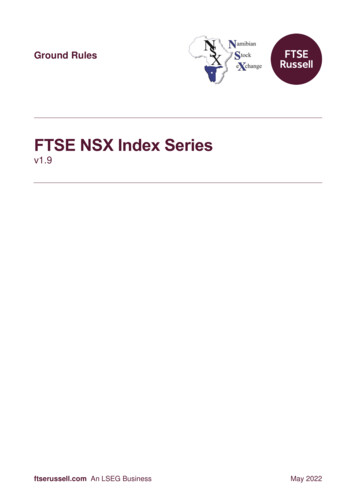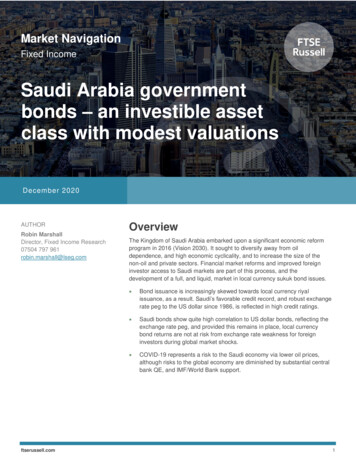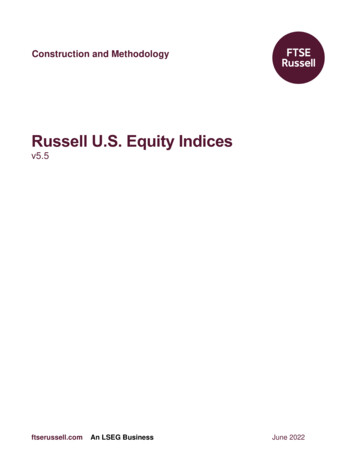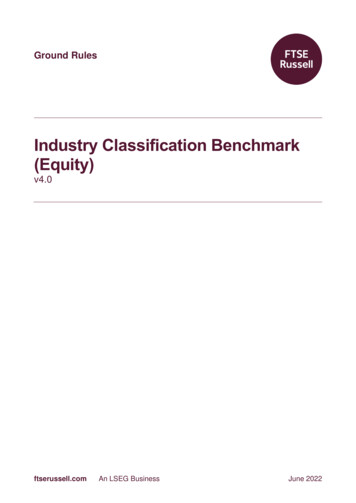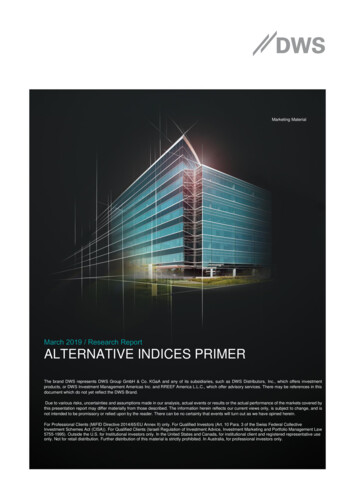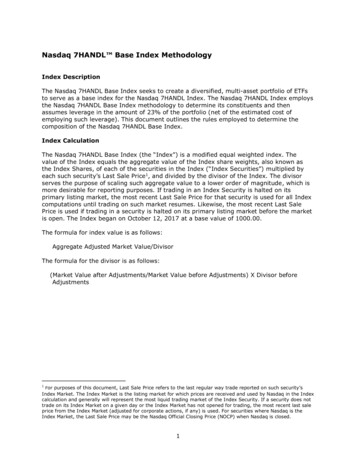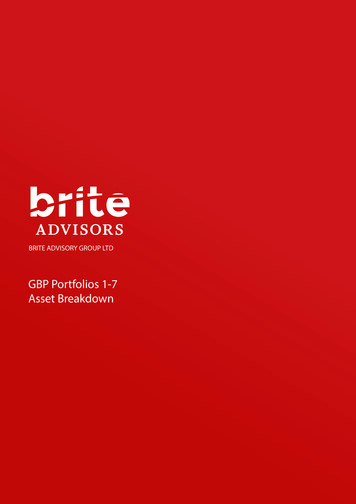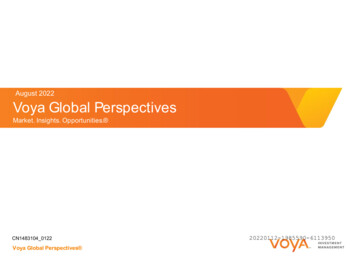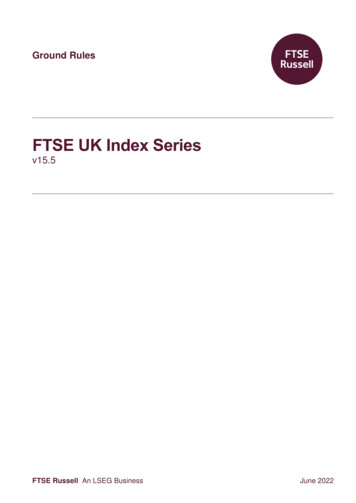
Transcription
Ground RulesFTSE UK Index Seriesv15.5FTSE Russell An LSEG BusinessJune 2022
Contents1.0Introduction . 32.0Management Responsibilities . 53.0FTSE Russell Index Policies . 74.0Security Inclusion Criteria . 95.0Nationality .126.0Screens Applied to Eligible Securities.147.0Index Qualification Criteria .178.0Periodic Review of Constituents .199.0Corporate Actions and Events .2410.0 Treatment of Dividends .2711.0 Industry Classification Benchmark (ICB) .2812.0 Announcing Changes .29Appendix A: Index Opening and Closing Hours .30Appendix B: Status of Indices .31Appendix C: FTSE 350 Yield indices – Review Process and Maintenance .32Appendix D: Volume Data used in Liquidity Screen.35Appendix E: Further Information .36FTSE Russell An LSEG Business FTSE UK Index Series, v15.3, June 20222 of 36
Section 1Introduction1.0Introduction1.1The FTSE UK Index Series is designed to represent the performance of the major capital and industrysegments of the UK market. The FTSE UK Index Series includes the following indices:1.1.1FTSE 100)FTSE 250)FTSE 350)FTSE 350 Supersectors)FTSE 350 Sectors)FTSE SmallCap)FTSE All-Share)FTSE Fledgling)FTSE 350 Higher Yield)FTSE 350 Lower Yield)FTSE All-Share Sectors)FTSE All-Small)FTSE All-Small Sectors)FTSE 350 Industry Sectors)Real Time CalculationEnd of Day CalculationThe following variants are, or if requested may be, calculated for certain indices within the indexseries: Capital and total return indices. Net total return indices based on specified withholding tax rates. Indices calculated in currencies other than the base currency (GBP). Currency hedged indices. Capped indices; for full details see the FTSE Russell Capping Methodology guide. Sector indices.Additional customised variants can be calculated on request including indices with industry and sectorexclusions. Selected indices are calculated and disseminated on a real time basis.1.1.2The FTSE UK Index Series does not take account of ESG factors in its index design.1.1.3The base currency of the benchmark is GBP. Index values may also be published in other currencies.FTSE Russell An LSEG Business FTSE UK Index Series, v15.5, June 20223 of 36
1.1.4For full details of Capped indices please see the Capping Methodology Guide.1.2FTSE RussellFTSE Russell is a trading name of FTSE International Limited, Frank Russell Company, FTSE GlobalDebt Capital Markets Limited (and its subsidiaries FTSE Global Debt Capital Markets Inc. and FTSEFixed Income Europe Limited), FTSE Fixed Income LLC, The Yield Book Inc and Beyond Rating1.3Index Objective and Intended Use1.3.1The indices and index statistics are intended to reflect the UK market, or those tranches of the marketdefined by the index titles and to facilitate their detailed analysis.1.3.2FTSE Russell hereby notifies users of the index series that it is possible that circumstances, includingexternal events beyond the control of FTSE Russell, may necessitate changes to, or the cessation of,the index series and therefore, any financial contracts or other financial instruments that reference theindex series or investment funds which use the index series to measure their performance should beable to withstand, or otherwise address the possibility of changes to, or cessation of, the index series.1.3.3Index users who choose to follow this index series or to buy products that claim to follow this indexseries should assess the merits of the index’s rules-based methodology and take independentinvestment advice before investing their own or client funds. No liability whether as a result ofnegligence or otherwise is accepted by FTSE Russell (or any person concerned with the preparationor publication of these Ground Rules) for any losses, damages, claims and expenses suffered by anyperson as a result of: any reliance on these Ground Rules, and/orany errors or inaccuracies in these Ground Rules, and/orany non-application or misapplication of the policies or procedures described in these GroundRules, and/orany errors or inaccuracies in the compilation of the Index or any constituent data.1.4IOSCO1.4.1FTSE International Limited (FTSE) considers that the FTSE UK Index Series meets the IOSCOPrinciples for Financial Benchmarks as published in July 2013.Full details can be accessed at www.iosco.org.Details of FTSE Russell’s Statement of Compliance with respect to the IOSCO Principles can beaccessed using the following link:IOSCO Statement of PrinciplesFTSE Russell An LSEG Business FTSE UK Index Series, v15.5 June 20224 of 36
Section 2Management Responsibilities2.0Management Responsibilities2.1FTSE International Limited (FTSE)2.1.1FTSE is the benchmark administrator of the index series.12.1.2FTSE is responsible for the daily calculation, production and operation of the FTSE UK Index Seriesand will: maintain records of the index weightings of all constituents; make changes to the constituents and their weightings in accordance with the Ground Rules; carry out the periodic index reviews of the FTSE UK Index Series and apply the changes resultingfrom the reviews as required by the Ground Rules; publish changes to the constituent weightings resulting from their ongoing maintenance and theperiodic reviews; disseminate the indices.2.1.3FTSE is also responsible for monitoring the performance of the FTSE UK Index Series throughout theday and will determine whether the status of each index should be Firm, Indicative or Held (seeAppendix B).2.2FTSE Russell External Advisory Committees2.2.1To assist in the oversight of the indices, FTSE Russell has established the following external advisorycommittees, consisting of senior market practitioners, providing guidance (as stipulated in their termsof reference) to ensure FTSE Russell indices continue to reflect their underlying market: 2.2.2FTSE Russell Europe, Middle East & Africa Regional Equity Advisory CommitteeFTSE Russell Industry Classification Advisory CommitteeFTSE Russell Policy Advisory BoardThe Terms of Reference of the FTSE Russell advisory committees are set out on the FTSE Russellwebsite and can be accessed using the following link:Terms-of-Reference1The term administrator is used in this document in the same sense as it is defined in Regulation (EU) 2016/1011 of the EuropeanParliament and of the Council of 8 June 2016 on indices used as benchmarks in financial instruments and financial contracts or tomeasure the performance of investment funds (the European Benchmark Regulation) and The Benchmarks (Amendment and TransitionalProvision) (EU Exit) Regulations 2019 (the UK Benchmark Regulation).FTSE Russell An LSEG Business FTSE UK Index Series, v15.5, June 20225 of 36
2.3Amendments to these Ground Rules2.3.1These Ground Rules shall be subject to regular review (at least once a year) by FTSE Russell toensure that they continue to best reflect the aims of the index series. Any proposals for significantamendments to these Ground Rules will be subject to consultation with FTSE Russell advisorycommittees and other stakeholders if appropriate. The feedback from these consultations will beconsidered by the FTSE Russell Index Governance Board before approval is granted.2.3.2As provided for in the Statement of Principles for FTSE Russell Equity Indices, where FTSE Russelldetermines that the Ground Rules are silent or do not specifically and unambiguously apply to thesubject matter of any decision, any decision shall be based as far as practical on the Statement ofPrinciples. After making any such determination, FTSE Russell shall advise the market of its decisionat the earliest opportunity. Any such treatment will not be considered as an exception or change to theGround Rules, or to set a precedent for future action, but FTSE Russell will consider whether theGround Rules should subsequently be updated to provide greater clarity.FTSE Russell An LSEG Business FTSE UK Index Series, v15.5 June 20226 of 36
Section 3FTSE Russell Index Policies3.0FTSE Russell Index PoliciesThese Ground Rules should be read in conjunction with the following policy documents which can beaccessed using the links below:3.1FTSE UK Index Series Guide to Calculation Methods3.1.1The aim of the guide is to describe how the indices are calculated, to facilitate users replicating theindices in order to support their investment and trading activities and to assist users in understandingthe factors which influence the performance of the indices.FTSE UK Index Series Guide to Calc.pdf3.2Corporate Actions and Events Guide3.2.1Full details of changes to constituent companies due to corporate actions and events can beaccessed in the Corporate Actions and Events Guide using the following link:Corporate Actions and Events Guide.pdf3.3Statement of Principles for FTSE Russell Equity Indices (the Statement of Principles)Indices need to keep abreast of changing markets and the Ground Rules cannot anticipate everyeventuality. Where the Ground Rules do not fully cover a specific event or development, FTSERussell will determine the appropriate treatment by reference to the Statement of Principles whichsummarises the ethos underlying FTSE Russell’s approach to index construction. The Statement ofPrinciples is reviewed annually and any changes proposed by FTSE Russell are presented to theFTSE Russell Policy Advisory Board for discussion before approval by the FTSE Russell IndexGovernance Board.The Statement of Principles can be accessed using the following link:Statement of Principles.pdf3.4Queries, Complaints and AppealsA constituent or prospective constituent company (or professional advisor acting on behalf of thecompany), a national organisation or a group of no fewer than ten users of the Indices from differentorganisations acting in their professional capacity may appeal against decisions taken by FTSERussell.FTSE Russell An LSEG Business FTSE UK Index Series, v15.5, June 20227 of 36
FTSE Russell’s complaints procedure can be accessed using the following link:Benchmark Determination Complaints Handling Policy.pdfFTSE Russell’s appeal process can be accessed using the following link:Appeals Against Decisions.pdf3.5Index Policy for Trading Halts and Market Closures3.5.1Guidance for the treatment of index changes in the event of trading halts or market closures can befound using the following link:Index Policy for Trading Halts and Market Closures.pdf3.6Index Policy in the Event Clients are Unable to Trade a Market or a Security3.6.1Details of FTSE Russell’s treatment can be accessed using the following link:Index Policy in the Event Clients are Unable to Trade a Market or a Security.pdf3.7Recalculation Policy and Guidelines3.7.1The FTSE Global Equity Index Series are recalculated whenever errors or distortions occur that aredeemed to be significant. Users of the FTSE Global Equity Index Series are notified throughappropriate media.For further information refer to the FTSE Russell Recalculation Policy and Guidelines document whichis available from the FTSE Russell website using the link below or by contactinginfo@ftserussell.com.Equity Index Recalculation Policy and Guidelines.pdf3.8Policy for Benchmark Methodology Changes3.8.1Details of FTSE Russell’s policy for making benchmark methodology changes can be accessed usingthe following link:Policy for Benchmark Methodology Changes.pdf3.9FTSE Russell Governance Framework3.9.1To oversee its indices, FTSE Russell employs a governance framework that encompasses product,service and technology governance. The framework incorporates the London Stock ExchangeGroup’s three lines of defence risk management framework and is designed to meet the requirementsof the IOSCO Principles for Financial Benchmarks2, the European benchmark regulation3 and the UKbenchmark regulation4.The FTSE Russell Governance Framework can be accessed using thefollowing link:FTSE Russell Governance Framework.pdf2IOSCO Principles for Financial Benchmarks Final Report, FR07/13 July 2013Regulation (EU) 2016/1011 of the European Parliament and of the Council of 8 June 2016 on indices used as benchmarks in financialinstruments and financial contracts or to measure the performance of investment funds4The Benchmarks (Amendment and Transitional Provision) (EU Exit) Regulations 20193FTSE Russell An LSEG Business FTSE UK Index Series, v15.5 June 20228 of 36
Section 4Security Inclusion Criteria4.0Security Inclusion Criteria4.1Eligible Securities4.1.1Only Premium Listed Equity Shares, as defined by the Financial Conduct Authority in its Listing RulesSourcebook, which have been admitted to trading to the London Stock Exchange with a Sterlingdenominated price on SETS are eligible for inclusion in the FTSE UK Index Series.4.1.2Eligible securities are required to pass screens as detailed in Section 6 before being included in theFTSE UK Index Series (see Section 6).4.1.3All securities are assigned a nationality in accordance with the rules as set out in Section 5.4.1.4Multiple LinesQuarterly ReviewWhere there are multiple lines of listed equity capital in a company, all are included and pricedseparately, provided that the secondary line’s full market capitalisation (i.e. before the application ofany investability weightings), is greater than 25% of the full market capitalisation of the company’sprincipal line and the secondary line satisfies the eligibility rules and screens in its own right in allrespects (including the minimum market capitalisation screen, see rule 8.3.5).Should the investable market capitalisation of a secondary line, which is already a constituent of theFTSE All-Share Index, fall below the minimum investable market capitalisation threshold for twoconsecutive quarters, it will be deleted from the relevant index at that review.Annual ReviewShould the full market capitalisation of a secondary line, which is already a constituent of the FTSEAll-Share Index, fall below 20% of the full market capitalisation of the company’s principal line at anannual review, the secondary line will be deleted from the relevant index unless its full marketcapitalisation remain above the qualification level for continued inclusion as a constituent of the FTSEAll-Share Index at that review.Should the investable market capitalisation of a secondary line, which is already a constituent of theFTSE All-Share Index, fall below the minimum investable market capitalisation threshold for twoconsecutive quarters, it will be deleted from the relevant index at that review.FTSE Russell An LSEG Business FTSE UK Index Series, v15.5, June 20229 of 36
Note: There is no minimum qualification level for the FTSE Fledgling, therefore should the full marketcapitalisation of a secondary line, which is already a constituent of the FTSE Fledgling Index, fallbelow 20% of the full market capitalisation of the company’s principal line at an annual review, thesecondary line will remain in the index subject to continuing to satisfy the eligibility rules and screensin its own right in all respects.For the avoidance of doubt, there is no minimum investable market capitalisation requirement for theFTSE Fledgling Index.FTSE Russell An LSEG Business FTSE UK Index Series, v15.5 June 202210 of 36
4.1.5Partly Paid SharesWhere a company's shares are issued partly, or nil, paid and the call dates are already determinedand known, the market price will, for the purposes of calculating its market capitalisation, be adjustedso as to include all such calls (i.e. the fully paid price).4.2Ineligible Securities4.2.1The following investment entities are regarded as ineligible: Companies whose business is classified by the Industry Classification Benchmark as Open Endand Miscellaneous Investment Vehicles (30205000). This includes Split Capital Investment Trustswhere instead of the use of a single class of ordinary share, the structure is split into separateincome and capital classes in which the two (or more) classes have different residual entitlementsto assets and/or income after meeting the requirements of any other classes or borrowings (note:this does not include Split Capital Trusts with ordinary shares accompanied by zero dividendpreference shares, whereby the ordinary share remains eligible in the same manner as aconventional Investment Trust); Venture Capital Trusts (VCTs); Convertible preference shares and loan stocks will be excluded until converted into eligible EquityShares. Where a unit comprises equity and non-equity it will not be eligible for inclusion.FTSE Russell An LSEG Business FTSE UK Index Series, v15.5 June 202211 of 36
Section 5Determining Nationality5.0Nationality5.1.1A company will be allocated to a single country. A company that has been assigned UK nationality byvirtue of these Ground Rules will also be assigned UK nationality in the FTSE Global Equity IndexSeries. However, a company assigned UK nationality under the FTSE Global Equity Index Series willnot be automatically eligible for UK nationality under these rules.5.1.2If a company is UK incorporated, FTSE will allocate the company UK nationality provided: 5.1.3If a company is not incorporated in the UK, the company must meet the following conditions in orderto be considered eligible for UK Nationality assignment: 5.1.4The company has its sole listing in the UK.The company has a minimum free float of 10%5The company must publicly acknowledge adherence to the principles of the UK CorporateGovernance Code, pre-emption rights and the UK Takeover Code as far as practicable.The company must have a minimum free float of 25%5.In circumstances other than those of Rule 5.1.2, FTSE will base its recommendation on itsassessment of various factors including, but not necessarily limited to, the following: The investor protection regulations present in the country of incorporation;The country in which the company is domiciled for tax purposes;The location of its factors of production;The location of its headquarters;The location of company meetings;The composition of its shareholder base;The membership of its board of directors;The currency denomination of the company’s shares;The perception of investors.In certain circumstances, outlined in Rules 5.1.5 to 5.1.8, consideration will also be given to therelative liquidity of trading in those countries where the company’s shares trade. In calculating theliquidity associated with a country, trading volumes will be amalgamated from all venues which haveadmitted the shares to trading based on a listing conferred by that country’s listing authority. Trades5For the purposes of Rules 5.1.2 and 5.1.3, the calculation of the minimum free float will be based on the ordinary share capital issued bythe company and may include shares that would otherwise be excluded solely because they are subject to a lock-in clause of twelvemonths or less from their first day of trading, but that would in all other respects be considered part of a company’s free float.FTSE Russell An LSEG Business FTSE UK Index Series, v15.5, June 202212 of 36
taking place on multi-lateral trading facilities will be included in the calculation and assigned to thecountry that conferred the listing to the company provided that the country of listing and the multilateral trading facility operate within a similar time zone.5.1.5If a company is incorporated in the UK, has a listing in the UK and listings in other countries on aneligible exchange (as classified within the FTSE Global Equity Index Series), FTSE will normallyassign the country to the UK provided the liquidity in the UK passes FTSE’s liquidity test for indexinclusion.5.1.6If a company is incorporated in a developed country other than the UK, is listed on an eligibleexchange in that country and in the UK (and potentially other developed countries), FTSE willnormally only assign UK nationality if the company fails FTSE’s liquidity tests in its country ofincorporation, passes the liquidity tests in the UK, and liquidity is higher in the UK than any othercountry.5.1.7If a company is incorporated in a developed country other than the UK, has no listing in that countrybut is listed in the UK and potentially other countries on an eligible exchange, FTSE will normally onlyassign UK nationality if liquidity is highest in the UK.5.1.8If a company is incorporated in a country other than a developed country, it will not be eligible for UKnationality unless the country of incorporation is a country that is internationally recognised as havinga low taxation status and that has been approved by FTSE. For companies incorporated in approvedlow taxation countries, FTSE may assign UK nationality if liquidity in the UK is higher than in any othercountry. A current list of the approved low taxation jurisdictions can be accessed using the followinglink:Low Taxation Jurisdictions.pdf5.1.9Once a company has been assigned a UK nationality by virtue of the liquidity tests in Rules 5.1.6 to5.1.8, if it subsequently fails the liquidity test in the UK, or if there is a country with greater liquidity fortwo consecutive annual reviews, FTSE will review the company’s nationality assignment.5.1.10 Other than meeting the conditions of Rule 5.1.2 or 5.15, should a company make a change to itscircumstances (such as a change in incorporation or adoption of an additional listing), FTSE maydefer the consideration of whether to change a company’s nationality assignment for a minimumperiod of three months up to a maximum period of up to 12 months; this will allow FTSE to properlyassess the subsequent evolution of its trading liquidity and of the other criteria listed in Rule 5.1.4. Iffollowing such an assessment period, FTSE decides to change a company’s nationality assignment,the change will become effective at the index quarterly review following publication of the decision.5.2Where a company’s nationality has been determined as UK, if the shares are traded in CDI form(Crest Depository Interest), the CDI will be considered as eligible subject to meeting all other indexeligibility criteria.FTSE Russell An LSEG Business FTSE UK Index Series, v15.5 June 202213 of 36
Section 6Screens Applied to Eligible Securities6.0Screens Applied to Eligible Securities6.1Eligible securities are required to pass the following screens before being added to the FTSE UKIndex Series.6.2PriceThere must be an accurate and reliable price for the purposes of determining the market value of acompany.6.3Minimum Voting Rights6.3.1Companies assigned a developed market nationality are required to have greater than 5% of thecompany’s voting rights (aggregated across all of its equity securities, including, where identifiable,those that are not listed or trading) in the hands of unrestricted shareholders or they will be deemedineligible for index inclusion.The voting rights screen is applied to any potential new constituents on a quarterly basis, and existingconstituents will be tested on an annual basis in conjunction with the June review.6.3.2The minimum voting rights screen was introduced in 2017, at the time any existing constituents with adeveloped market nationality who did not meet the above requirement were afforded a five yeargrandfathering period to comply. If subsequently they continue to fail the minimum voting rightsscreen they will be removed from FTSE Russell indices at the September 2022 review.6.3.3The percentage of a company’s voting rights in public hands is calculated as:The number of votes in the hands of shareholders that are unrestricted as determinedby the application of FTSE Russell free float definitionsThe total number of votes conferred by the shares oustanding of all the company ′ svoting securities including those that have not been admitted to trading on a regulated venueFor example, Company A has 100m listed Class A shares each conferring one vote, free float is65%. It also has 300m unlisted Class B shares each conferring 10 votes.The test to assess whether the listed Class A line has the required greater than 5% of the company’svoting rights is as follows:FTSE Russell An LSEG Business FTSE UK Index Series, v15.5, June 202214 of 36
65m (i. e. 100m Class A voting rights 65% float)3.1bn (i. e. 100m Class A 3bn Class B) 2.097% of the company ′ s voting rights in public hands6.3.4For a company with a Dual Class Share Structure (DCSS) which is subject to a five -year sunsetclause, and where the enhanced voting line is specifically referred to as Specified Weighted VotingRights shares (SWVRs), the SWVRs will generally be deemed to confer one vote per share for thepurposes of the minimum voting rights test (see illustrative example below). However, if FTSERussell becomes aware that a change in control has occurred which has triggered the enhancedvoting power on all matters, in accordance with the SWVR guidelines as defined by the FCA, theenhanced voting ratio will be used for the purposes of the test (see rule 6.3.3). Any constituentconsequently deemed to be failing the voting rights’ requirement as a result of increased votingpower, will be removed from the UK Series in conjunction with the following quarterly index review.Illustrative example:Company A has 100m Premium listed Ordinary shares each conferring one vote with a free float of100%. It also has 25m unlisted Specified Weighted Voting Rights Shares each conferring one vote(except in specific circumstances where each share confers 20 votes).For the purposes of the minimum voting rights test, the 25m unlisted Specified Weighted VotingRights Shares are deemed to confer one vote per share.(100m Ord shares x 100% float x 1 voting right) (25m x 1 voting right)100m / 125m 80% of the company's voting rights are in public hands6.4Investability WeightingsA. Initial WeightingConstituents of the FTSE UK Index Series are adjusted for free float and foreign ownership limits(where applicable to UK investors).Free float is calculated using available published information rounded to 12 decimal places.To be eligible for inclusion in the FTSE UK Index Series, a security must have a minimum freefloat of 10% if the issuing company is UK incorporated and a minimum free float of 25% if it isnon-UK incorporated.However, a new company may be initially included in the FTSE UK Index Series with a free floatbelow the above parameters (provided it is above 5%*) where the free float is expected to meetthe minimum requirements within 12 months of the company’s first day of trading (refer to Rules5.1.2 and 5.1.3).*New companies with an initial free float of 5% or below are not eligible for inclusion in the FTSEUK Index Series.Details on free float restrictions can be accessed using the following link:Free Float Restrictions.pdf6.5Foreign Ownership Restrictions and Minimum Headroom Requirement6.5.1For the avoidance of doubt, a security which restricts the number of shares that a UK investor canhold may be included in the FTSE UK Index Series with an investability weight equal to the ForeignOwnership Limit (see Foreign Ownership Restrictions and Minimum Foreign Headroom RequirmentFTSE Russell An LSEG Business FTSE UK Index Series, v15.5 June 202215 of 36
Rule B). However, the actual calculated free float will be referenced to determine if the security meetsthe minimum free float criteria for index eligibility. For example, Company A (non-UK incorporated)has a calculated free float of 62% and a Foreign Ownership Limit (which imposes a limit on UKinvestors) of 49%. Company A is deemed to meet the minimum free float requirement but will beincluded in the index with an investability weight of 49%.Further details of the Foreign Ownership Restrictions can be accessed using the following link:FTSE UK Index Series - Foreign Ownership Restrictions andMInimum Foreign Headroom Requirement.pdf6.6SizeIn order to determine index membership, all companies with eligible securities will be ranked by theirfull market capitalisation (i.e. before the application of any investability weightings).Only the listed equity shares of a constituent company will be included in the calculation of its marketcapitalisation.Where a company has two or more classes of listed equity shares, the secondary lines will beincluded in the calculation of the market capitalisation of the company, based on the market price ofthat secondary line.For the avoidance of doubt, for companies with a dual class share structure, the unlisted specifiedweighted voting rights shares will not be included in the calculation of the company’s full marketcapitalisation for ranking purposes.6.7LiquidityFor full details of the liquidity screening please refer to the FTSE UK Index Series - Guide toCalculation Method for the Median Liquidity Test which can be accessed using the following link:Guide to Calculation Methods for UK Liquidity.pdfFTSE Russell An LSEG Business FTSE UK Index Series, v15.5 June 202216 of 36
Section
FTSE Russell An LSEG Business FTSE UK Index Series, v15.5, June 2022 5 of 36 Section 2 Management Responsibilities 2.0 Management Responsibilities 2.1 FTSE International Limited (FTSE) 2.1.1 FTSE is the benchmark administrator of the index series.1 2.1.2 FTSE is responsible for the daily calculation, production and operation of the FTSE UK Index Series
